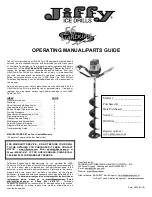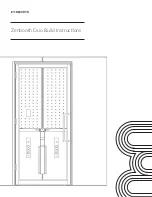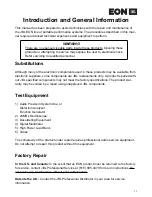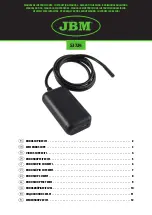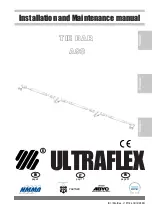
EN
9
ECO switch [ Fig. O5 ]:
In order to save energy (up to 15 %), the cut-out pressure on the pump
can, depending on the individual application, be regulated between ECO
and MAX (the pressure difference between ECO and MAX totals
approx. 1 bar).
v
Turn the ECO rotary switch
r
to the required position.
Note on the use of sprinklers:
Depending on the flow rate of the sprinkler, an uneven watering pattern
may occur through the pump being switched on and off automatically.
4. STORAGE
To put into storage [ Fig. S1 / O1 ]:
If there is a risk of frost, the Pressure Tank Unit must be emptied
and stored where it will not become frozen. The product must be stored
away from children.
1. Turn the rotary switch
q
to OFF.
2. Unplug the mains connection for the pump.
3. Open the delivery side consumer.
4. Unscrew the end cap
9
and screw out the check valve
t
using
a suitable tool.
5. Tip the pump in the direction of the water outlet so that the Pressure
Tank Unit is completely drained off.
6. Store the pressure tank unit in a dry, frost-free place.
Disposal:
(in accordance with RL2012/19/EC)
The product must not be disposed of to normal household waste.
It must be disposed of in line with local environmental regulations.
IMPORTANT!
v
Dispose of the product through or via your municipal recycling
collection centre.
5. MAINTENANCE
DANGER! Electric shock!
v
Pull out mains plug before undertaking any maintenance.
Clean suction filter [ Fig. M1 / O1 / M2 ]:
1. Turn the rotary switch
q
to OFF.
2. If necessary, close all the shut-off devices on the intake side.
3. Unscrew and remove cover
0
of the filter chamber.
4. Draw out filter unit
z u
vertically upwards.
5. Hold beaker
z
firmly, turn filter
u
anti-clockwise A and draw out B
(bayonet fitting).
6. Clean beaker
z
under running water and clean the filter
u
e. g. with
a soft brush.
7. Refit filter again in reverse order.
Cleaning the check valve [ Fig. M3 / O1 ]:
1. Turn the rotary switch
q
to OFF.
2. If necessary, close all valves on the intake side.
3. Open all pressure side outlets, so that the pressure side is
depressurised.
4. Unscrew the end cap
9
and drain off the water
5. Screw out the cover
t
of the check valve (if applicable using a suitable
tool).
6. Remove the valve body
i
and wash it under running water.
7. Refit in reverse order.
8. Switch the Pressure Tank Unit back on again (see 3. OPERATION).
6. TROUBLESHOOTING
DANGER! Electric shock!
v
Unplug the cable at the mains before troubleshooting.
Work on the electrical parts must only be carried out by
GARDENA Service Centres.
Problem
Possible Cause
Remedy
The pump sucks nothing up
Rotary switch is not turned to
START
.
v
Restart the pump
(see 3. OPERATION).
The pump is sucking air
through a leak at a connection
on the suction side.
v
Check all connections and
make them air-tight as
necessary.
Pump is not adequately primed
with the liquid to be pumped.
v
Fill the pump and ensure that
the water is able to flow
back into the pressure line
(see 3. OPERATION).
Air cannot escape on the pres-
sure side, because the pressure
side outlets are closed.
v
Open the pressure side
outlets.
End of the suction hose is not
in the water, the non-return
valve at the end of the suction
hose is missing or leaking, the
suction hose is kinked, connec-
tions are leaking or the suction
filter is blocked.
v
Check the complete suction
hose from suction point
through to the pump for leak-
tightness and repair any leaks
as necessary. Check the intake
side water supply. If applicable,
clean the suction filter.
Pump motor does not start
or stops suddenly during
operation
Mains plug not plugged in.
v
Insert mains plug into a mains
socket (230 V AC).
Power failure.
v
Check fuse and cables.
Thermo circuit breaker
activated (orange warning
lamp lights up and the
pump housing is heated).
1. Turn the rotary switch to
OFF
.
2. Open consumer
(relief pressure).
3. Ensure sufficient ventilation
and allow the pump to cool for
approx. 15 min.
4. Restart the pump
(see 3. OPERATION).
The dry-running safety has
been activated (orange warning
lamp lights up).
v
Check the water supply on
the intake side and restart the
pump (see 3. OPERATION).
Water removal in
Auto
mode
too high. Pressure monitoring
has been activated (orange
warning lamp lights up).
v
Turn the rotary switch to
Man
.
(Warning! Dryrunning
safety is deactivated).
Pump motor runs,
but quantity delivered
or pressure fall away
suddenly
Leak on the suction side.
v
Repair the leak.
Too little water on intake side.
v
Throttle the pump on the
pressure side so that the flow
quantity on the suction side
is governed by that on the
pressure side.
Suction filter, check valve or
backflow preventer at the end of
the suction hose is blocked.
v
Clean the suction filter, check
valve or backflow preventer.
Pump switches on and off
too frequently
Leakage on delivery side.
v
Check the delivery side
for leaks and remove as
necessary.
Pressure in the boiler is too
low.
v
Top up the air in the storage
tank (see below).
Boiler diaphragm is damaged.
v
Contact GARDENA Service.
Pump switches on and off
several times before shutting
down
Installation-related fluctuations
in pressure.
v
Turn ECO switch slightly
towards
MAX
.
Orange warning lamp
illuminates
Pressure dropping below
0.8 bar during operation.
v
Turn the rotary switch to
“
Man
” (see section entitled
“
Manual mode
” in the
operating instructions)
– or –
v
restart the pump (see section
3. OPERATION) and then limit
water consumption until the
pressure increases to above
0.8 bar (rotary switch will
automatically spring to
“
Auto
”).
Top up the air in the storage tank [ Fig. T1 ]:
The pressure in the storage tank must be approx. 1.0 bar.
To top up the air, an air pump / tyre pump with a pressure gauge
(manometer) is required.
1. Unscrew the protective cover
a
.
2. Open all pressure side outlets, so that the pressure side is
depressurised.
3. Attach the air pump / tyre pump to the boiler valve
s
and pump air in
until the air pump/tyre pump pressure gauge shows approx. 1.0 bar.
4. Screw the protective cover
a
back on.











